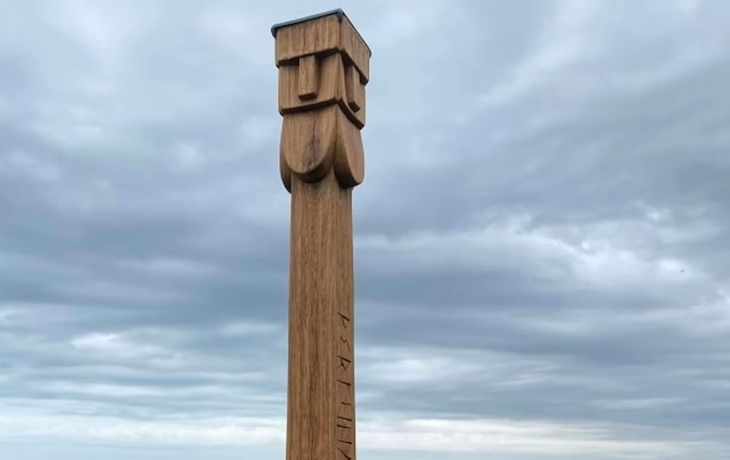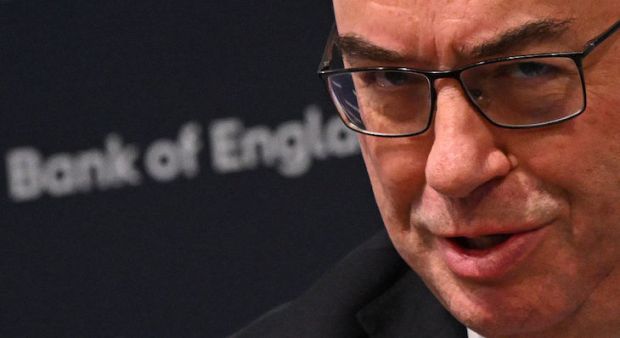One of the stranger events of the summer of 2023 is the sudden and unexplained appearance, one night in early August, of an eight-foot tall carved wooden pole on a coastal path in Kent depicting the Baltic thunder god Perkūnas. The impressive sculpture is carved from a single piece of wood crowned by four stylised bearded faces, with an inscription in runic-style lettering up one side, ‘PERKUNAS 2023’.
No permission was sought to erect the carving, and its creator is unknown – as is the purpose of the installation. Is it a gift from the artist? A pagan religious act? An image set up for protection? One social media user suggested that, since the spot where the pole stands is at the closest point to Continental Europe, a Baltic worshipper of Perkūnas might have set up the sculpture there as the next best thing to making an offering to Perkūnas on native soil.
As late as the 1780s, Catholic priests were still travelling to remote villages in Lithuania and instructing local people to cut down trees which they had been worshipping
Who is this mysterious Baltic god? Perkūnas (or Pērkons in Latvian) is broadly equivalent to the Slavic thunder god Perun and has similarities to the Norse god Thor. Like Thor, Perkūnas is not the supreme deity of the Baltic pantheon (unlike the Graeco-Roman thunder god Zeus/Jupiter) but he is one of its most important. Unlike the Norse god, Perkūnas does not strike thunder and lightning with a hammer – rather, the hooves of his heavenly steed pound the clouds to make thunder. Some mythologists have speculated that the mounted knight known as ‘Vytis’ who is the ancient emblem of Lithuania (as well as being used by dissidents in Belarus) was originally the mounted god Perkūnas, who was the foremost god worshipped by the pagan Grand Dukes of Lithuania. These rulers clung stubbornly to their pagan rites for longer than anyone else in Europe, only finally accepting Christianity in 1387.
Indeed, an earlier attempt to convert one Lithuanian leader, Mindaugas, went disastrously wrong in the 1260s. Realising how unpopular his conversion to Christianity was, Mindaugas recanted the new faith and tore the roof off the cathedral he had built in Vilnius (so it was open to the heavens) replacing Christian worship with altars to Perkūnas. According to one very unlikely story he then sacrificed his own daughter to the thunder god in expiation.
Perkūnas’s reputation in the Baltic is less bloodthirsty than this story might suggest. Perkūnas is strongly associated with the oak tree, and as late as the 1780s, Catholic priests were still travelling to remote villages in Lithuania and instructing local people to cut down trees which they had been worshipping. It was only after 1795, when Lithuania was incorporated into the Russian Empire, that Catholicism truly took root as Lithuanians united around the Catholic faith in resistance to Russian Orthodoxy. Yet Perkūnas persisted as a sort of personification of thunder itself; until recent decades, people going outside in a thunderstorm in Lithuania and Latvia would cover their heads and invoke Perkūnas’s protection.
Perkūnas is also a god synonymous with courage and bravery; his role as the divine horseman of the heavens links him to some of the earliest Indo-European myths about heavenly riders found from Europe to the Indian Subcontinent. It was the horse, after all, that brought the earliest speakers of the Proto-Indo-European language from the Pontic Steppe (now Ukraine) into the rest of Europe and much of Asia.
There is no equestrian element to Kent’s Perkūnas pole, and the sculpture’s iconographic inspiration is instead Slavic. The four faces at the top of the pole closely resemble the ‘Wolin idol’, an ancient Slavic wooden idol found by archaeologists in Poland in 1974. The Wolin idol seems to be a portrayal of Svetovit, a deity popular with the last West Slavic pagans before the conversion of the Poles and other Slavic peoples to Christianity in the tenth century. Since Svetovit may have been a manifestation of the Slavic thunder god Perun, the use of his image to portray Perkūnas has a certain logic to it; unfortunately, we have little evidence of how the ancient Balts portrayed Perkūnas himself.
Whatever its meaning, Kent’s Perkūnas pole will continue to attract curiosity. It has already attracted offerings, with a few flowers and petals appearing at the base of the carving. Perhaps the pole’s creator will come forward or, more intriguingly, he or she will choose to leave this tribute to a god far from home a perpetual mystery.
Got something to add? Join the discussion and comment below.
Get 10 issues for just $10
Subscribe to The Spectator Australia today for the next 10 magazine issues, plus full online access, for just $10.




















Comments
Don't miss out
Join the conversation with other Spectator Australia readers. Subscribe to leave a comment.
SUBSCRIBEAlready a subscriber? Log in